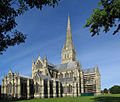Buildings and structures
Buildings
- c. 1250
- Western towers and north rose window of Notre Dame de Paris in the Kingdom of France are built. [1]
- Hexham Abbey, England completed (begun c. 1170).
- Konark Sun Temple in Odisha built. [2]
- 1250
- Château de Spesbourg, Holy Roman Empire built. [3]
- Ponts Couverts, Strasbourg, opened. [4]
- 1252 – Church of Alcobaça Monastery in Portugal completed. [5]
- c. 1252 – The Franciscan abbey of Claregalway Friary, in Claregalway, County Galway, Ireland is commissioned by Norman knight John de Cogan. [6]
- 1253 – Construction of the upper Basilica of San Francesco d'Assisi in Assisi, designed by Elia Bombardone, is completed.
- 1255 – New Gothic choir of the Tournai Cathedral in the Kingdom of France built. [7]
- 1256 – Construction of Hermann Castle in present-day Estonia is started. [8]
- 1257 – Construction of the Basilica di Santa Chiara in Assisi begun. [9]
- 1258 – The main body of the Salisbury Cathedral (begun in 1220) in Salisbury, England, is completed. [10]
- Western Front of Notre Dame de Paris (c. 1250)
- Hexham Abbey (c. 1250)
- Chateau de Spesbourg (c. 1250)
- Konark Sun Temple (c. 1250)
- Lakshminarayana Temple, Hosholalu (1250)
- Alcobaça Monastery church (1252)
- San Francesco d'Assisi (1253)
- Salisbury Cathedral (1258)







